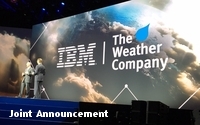 Insights from big data around the Internet of
Things got yet another big boost yesterday.
Insights from big data around the Internet of
Things got yet another big boost yesterday.
The IBM acquisition of the Weather Company’s digital platform represents a lot more than pushing IBM into the weather forecasting
business.
The acquisition is not a total surprise, since the companies have been working closely together for some time.
One longer term clue was the work the IoT group at IBM has been
doing to track weather in relative real time so that renewable energy companies can be more efficient in predicting and gauging energy usage, a program well underway for many months.
For that
massive project, IBM created technology to allow sky-aimed cameras to real-time measure cloud data, process it and link it into the cloud (the other one). I saw an impressive live demonstration of
this a few months back with results showing improved accuracy of rain forecasting by specific locations.
advertisement
advertisement
That system tied into messaging so that a consumer could receive a Tweet or text
messaging suggesting if they were planning to do their laundry today, they could receive a discount if they did it between 2 p.m. and 4 p.m. That would be a time that the weather forecasting system
suggested energy demand would be lowest, thereby balancing energy consumption. The messaging system was automated.
One shorter term clue of the deal was that Weather Company CEO David Kenny
was the opening keynote of the IBM Insight conference in Las Vegas this week and was highly visible with Bob Picciano, IBM senior vice president analytics, who ran entire show.
The duo
appeared together again yesterday morning to make the joint announcement on stage. And based on the highly produced video that went along with it, the deal has been known for some time, just not
announced.
The real significance of the acquisition is the linkage with IBM’s Watson technology, adding the real-time computational capabilities of the Weather Company to extend it well
beyond weather.
IBM also said it plans to further develop the data-driven advertising platform of The Weather Company.
That’s just the tip of this new IoT iceberg.